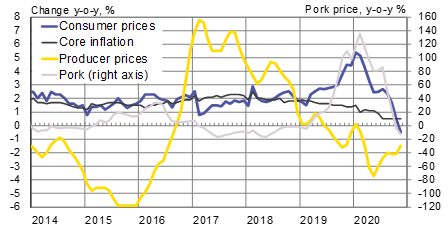BOFIT Weekly Review 50/2020
Pork prices swing Chinese consumer price inflation into negative territory
Consumer prices slid by 0.5 % y-o-y in November. The drop was led by a 13 % y-o-y drop in the price of pork, a major component of China’s average consumer shopping basket. Energy prices also were down on year. In contrast, core inflation, which excludes food and energy prices, continued to rise in November. It was the fifth month in a row that core inflation growth held at the 0.5 % level. Consumer price declines are rare in China. The last negative CPI reading was posted was in 2009 during the international financial crisis.
The decline in consumer prices was to be expected. In the second half of 2019, the African swine fever virus caused pork prices to double after a mass culling of infected pigs. While China’s commercial pig stocks and production have recovered somewhat this year and pork prices have started to decline, prices are still very steep compared to before the swine fever outbreak. The expected slow settling down of pork prices will dampen inflation for many months to come. Pork is central to the Chinese diet. China not only consumes about half of all global pork production, it is also the world’s largest pork producer by far.
November saw a decline in consumer prices, while the deflation of producer prices continued

Sources: China National Bureau of Statistics, CEIC and BOFIT.